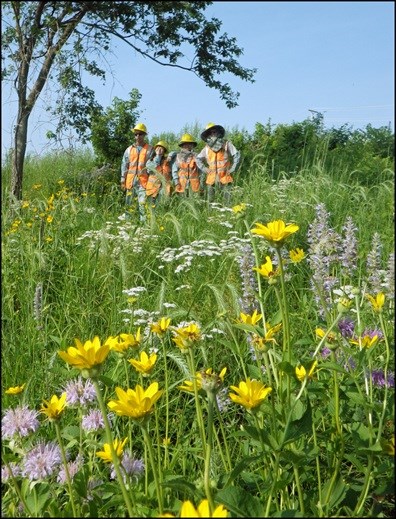
BeginningA plan is an important part of planting your own prairie. A written plan, with a schedule that you can follow will be helpful. Keeping a written record of your own or your contractor’s activities is a good way to keep track of how your prairie is progressing. Getting SeedsAfter deciding where you want to have a prairie and evaluating the conditions of your site, it is time to buy seeds and plants. When starting out, there are two important points to consider: choosing the right types of plants and planting as many different plants as possible. The plants you choose must be well suited to the site in order for them to thrive. If you have an especially dry site, choose plants that are adapted to those conditions. The more diverse your prairie, the more healthy and successful it will be, so plant as many different species of plants as you can. As time goes on, you can add more species, but the more types of plants you can initially grow, the better. Many typical prairie plants and their characteristics are presented here. When buying seed, be careful to avoid mixes that contain weed seed, straw, or non-native species. To ensure that you buy good quality seeds, go to a seed supplier who measures the seed by weight or percentage of Pure Live Seed (PLS). Pure Live Seed is a measure of how many of the seeds can be expected to germinate. Check content and viability ratings of the seeds so that you will know exactly what you are getting. Seed MixesSeed mixes consist of forb and grass seed. Forbs are beautiful and ecologically important, and grasses are aesthetically pleasing in that they provide the height and the structure of the prairie. Grasses also supply fuel for burns, which forbs don’t do as well. Grasses also have deep root systems to stabilize the soil. Prairie seed mixes are usually between 40-50% grasses and 50-60% forbs by weight. Seeding RatesHow many seeds should you plant? First, determine how many square feet or acres you are planting. An acre is 43,560 square feet or a square approximately 210 feet on a side. Usually 10 pounds of Pure Live Seed (PLS) is used per acre, or 8 ounces per every 1,000 square feet. Lighter or heavier rates are not desirable because the plants will be too scattered or too dense. Get exact seeding rates for your seed mixture from your supplier. Site PreparationSite preparation is very important to the success of your prairie. It will help to develop a good seedbed which will improve the germination rate of your plants. Good site preparation also removes weeds that would otherwise undermine the success of your prairie. This step should be done carefully because it helps ensure the success of your planting. Without the proper preparation, weed infestations are much more likely to occur and the success of your planting could suffer. MethodsA combination of herbicide treatment and mechanical cultivation is the most effective method for many sites, especially large areas such as old fields. The following spring, till one inch deep into the soil after the first rain to kill germinating weeds, then plant immediately.
Cover CropsA cover crop is a good idea if you have a site that may erode, or if you prepared your soil in the fall. A cover crop will kill many weeds while holding the soil in place. it is important not to let the cover crop go to seed. If you planted in the fall, the frost will kill the plants before they seed. If you planted in the summer, be sure to mow the site before the plants seed, approximately when the plants are 10-12 inches tall. Your prairie plants can be planted directly into the soil along with the remnants of the cover crop. The cover crop will hold the soil firmly in place until the prairie plants establish themselves.
Time to Start Planting or Seedings... Prairie Restoration
Restoration Projects
|
Last updated: December 26, 2017
